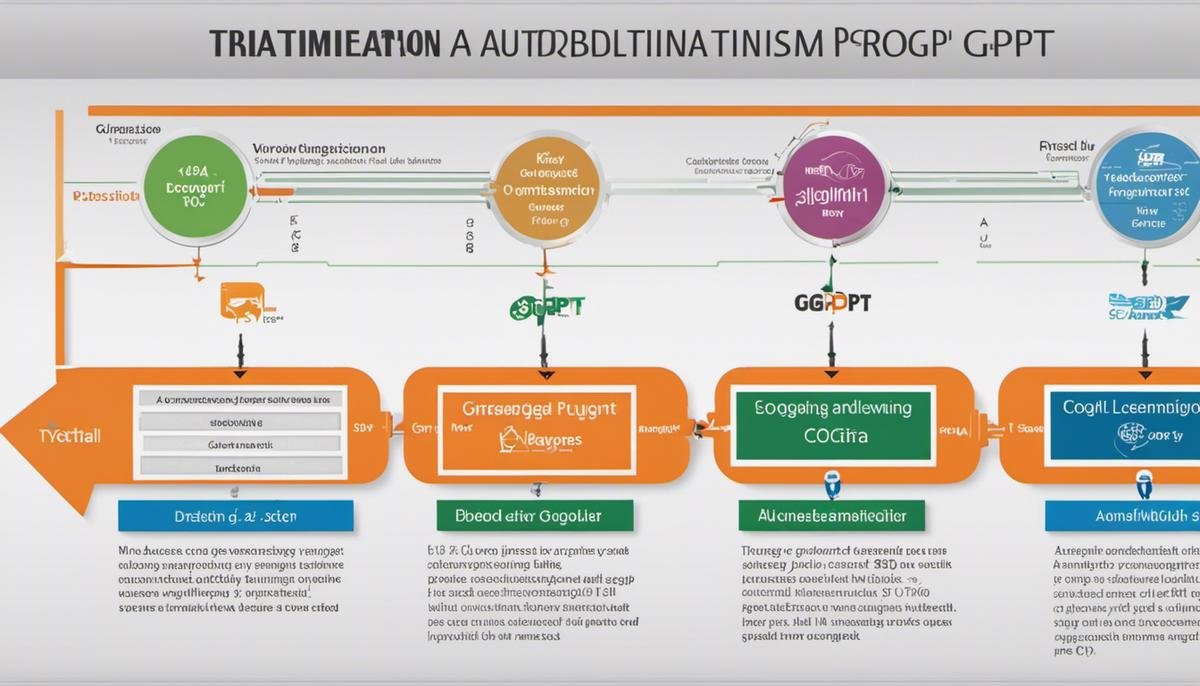Machine learning is an integral part of the futuristic world, empowering systems to automatically learn, improve from experience, and make decisions with minimal human intervention. Among the recent transformative innovations in this emerging field is Autogpt, a cutting-edge automated machine learning platform. This deep dive intends to shed light on the intricacies of Autogpt, delineating its capabilities, algorithms, and applications. It will offer invaluable insights on optimizing model performance, leveraging techniques for feature engineering, and selection to garner enhanced results. Additionally, you will understand the art of interpreting Autogpt models, comprehending its outputs and the critical metrics to evaluate accuracy. In addition, through real-world case studies, this exploration aims to demonstrate the successful application of Autogpt in diverse industrial arenas.
Understanding Autogpt
Understanding Auotgpt: An Introduction to Automated Machine Learning
AutoGPT, also known as Automatic Guided Personal Training, is a sophisticated form of machine learning deployed in numerous applications across various industries. Just like a human brain that learns from experiences, AutoGPT uses algorithms to learn from data, making predictions or decisions without being explicitly programmed to perform the task.
How AutoGPT functions
AutoGPT functions on the principles of automated machine learning, or AutoML. AutoML uses advanced algorithms that have the ability to learn and improve over time, enabling them to perform tasks more accurately. It aims to ease the process of implementing machine learning models by automating the process of model selection, hyperparameter tuning, iterative modeling, and model assessment.
Capabilities of Automated Machine Learning
Automated machine learning tools have the capacity to handle large volumes of data, identifying patterns and relationships within the data, and drawing conclusions, which would be challenging for a human mind. AutoGPT technology can be used in various industries including finance, healthcare, education, and more.
Understanding Algorithms
AutoGPT primarily focuses on the use of supervised learning algorithms, the most common form of machine learning. Through the use of labeled examples to predict future events, this approach trains the machine to make accurate predictions. For example, after receiving a series of labeled datasets, the model learns to infer the relationship between the input and the output. Reinforcement and unsupervised learning are other types of algorithms also used in varying contexts.
Data Types and Formats
AutoGPT is capable of handling a range of data types and formats. Numerical data, categorical data, text data, and image data can all be processed by AutoGPT systems. They can handle both structured and unstructured data.
Applications of Automated Machine Learning
Automated machine learning can be applied in a vast array of sectors. In healthcare, it can help predict patient readmissions or assist in detecting diseases. In finance, AutoGPT could be used to predict potential loan defaults or credit scoring. In marketing, it can help segment customers and target them with personalized marketing campaigns.
Remember, like any technology, while AutoGPT is powerful, its effectiveness largely depends on the quality of data it receives. Well-managed, high-quality data can lead to accurate predictive analysis, while incomplete or unstructured data can often result in less accurate predictions.

Optimizing Model Performance
Understanding AutoGPT Model Performance Optimization
AutoGPT, a part of OpenAI’s collection of powerful natural language processing models, excels at tasks such as text generation, classification, and more. However, to achieve the best possible results from AutoGPT, it’s necessary to optimize and fine-tune its performance. This involves a comprehensive understanding of hyperparameter tuning, regularization, model architecture tweaking, and an effective deployment strategy.
Hyperparameters that Influence AutoGPT
Optimization of an AutoGPT model hinges largely upon the correct identification and tuning of hyperparameters. These are the parameters that define the structure of the model and the way it’s trained. They include learning rate, batch size, weight decay, etc. Properly tuning these parameters can help to avoid problems with overfitting or underfitting and can generally enhance the model’s performance. Make use of tools such as cross-validation or grid search to find the best hyperparameters.
Importance of Regularization in AutoGPT
Regularization is a technique used to prevent overfitting by adding a penalty term to the loss function. In the context of AutoGPT, regularization techniques like L1 and L2 regularization, dropout, and early stopping can be used to improve the model’s generalization ability—making it perform better on unseen data.
Experimenting with Model Architecture
Apart from tuning the hyperparameters and adding regularization, one can also optimize AutoGPT by experimenting with its architecture. Choosing different numbers of layers or altering the type of layers used can have significant effects on the model’s outcomes. However, one should be careful since making the model too complex might lead to overfitting, and making it too simple might not capture the nuances of the data.
Feature Engineering and Selection in AutoGPT
Robust feature engineering is critical for maximizing performance. This may include creating new features from existing ones (feature creation), omitting redundant or irrelevant features (feature selection), standardizing or scaling features, or, in the case of text data, cleaning and normalizing the text.
Using techniques like Correlation Matrix with Heatmap to understand correlations between features, and Mutual Information techniques to identify conditional dependencies between variables can be helpful. Additionally, Recursive Feature Elimination or SelectKBest feature selection methods can be used to select the most critical features in your dataset.
Methods to Evaluate Model Performance
To gauge how well your optimization efforts are working, implement reliable performance metrics. With AutoGPT, you may typically use evaluation metrics like accuracy, precision, recall, or F1-score for classification tasks, and Mean Squared Error (MSE), Root Mean Squared Error (RMSE), or Mean Absolute Error (MAE) for regression tasks. Furthermore, using visual evaluation like a confusion matrix or Receiver Operating Characteristic (ROC) curves can give insight into your model’s performance.
Deployment and Iterative Enhancement
Finally, deployment and monitoring are vital parts of the process. Keep an eye on the model’s performance in real-world scenarios and note any areas where it underperforms. Make adjustments accordingly and remember that model optimization is an iterative process. By continually learning, improving, and refining, you can incrementally elevate the performance of your AutoGPT model.

Interpreting Autogpt Models
Understanding Autogpt Models: Unraveling the Mystery
Autogpt models are a variant of transformer-based language models that are trained extensively on a laundry list of internet text. To further interpret these models, one should understand that they generate outputs through predicting the probability of a specific word given the rest of the sentence so far. They do not possess the ability to access any external knowledge that has not been previously ingested into their feed. An important aspect of Autogpt is its concept of tokens, which comprise the basic building blocks of the model’s inputs and outputs. Text fed into Autogpt is converted into tokens representing varying lengths of text.
Interpreting Outputs and Results
Autogpt models follow a random sampling mechanism to generate a diverse set of outputs from a single input. They make choices at each step, informed by a probability across all potential outputs, taking into consideration the temperature setting. Higher temperatures produce more randomness, while lower temperatures generate more deterministic outcomes.
It’s crucial to remember that while comparing model outputs, the model is not providing a definitive or factual answer, but rather generating what it believes to be a plausible continuation of the input. These models do not inherently possess decision-making abilities, emotions, beliefs or opinions, nor can they engage in any form of conversation on a personal level.
Choosing the Right Metrics for Evaluation and Accuracy
Autogpt’s performance can be measured and optimized through a variety of metrics, which help gauge its efficiency on tasks involving text generation, summarization, and translation.
Perplexity is a commonly used evaluation metric, suggesting how surprised the model is by the data it is seeing, with lower perplexity denoting more accurate predictions. The BLEU (Bilingual Evaluation Understudy) score is another useful measuring metric, used when the model is involved in translation tasks. It calculates the similarity between the predicted translation and the actual human translation.
In terms of accuracy, it is imperative to mention that the model’s responses are usually influenced by the prompts given to it. The same question structured differently can yield different answers, and the amount of detail or specificity in the prompt also influences the output.
Last Modified: October 28, 2022
This article was last reviewed and updated on October 28, 2022, to ensure accuracy and relevance.

Autogpt Applied: Case Studies
Case Study 1: Coca-Cola’s Personalized Marketing with AutoGPT
As a multinational beverage corporation, Coca-Cola explored the use of GPT-3, the predecessor of AutoGPT, to create personalized marketing campaigns. They collected, organized, and anonymized the data, which was a combination of customer preferences, purchasing behavior data and specific regional trends. Coca-Cola then used this data to train their AI model. The model was designed to interpret data inputs and produce suitable marketing messages, making it possible for the company to engage consumers in a more personalized and efficient way.
This marketing strategy produced better than expected results. By using AI, Coca-Cola achieved a higher engagement rate with their target consumers. Importantly, the company confirmed that the use of AI significantly improved their return on investment (ROI) by reducing their cost to acquire a customer and increasing the customer lifetime value.
Case Study 2: Automating Content Creation at The Washington Post
The Washington Post, one of the largest news publishers in the U.S., used AI models such as GPT-3, the precursor to AutoGPT, to supplement the work of their journalists. The technology is implemented in an internal tool called Heliograf, which can automatically generate short reports and news updates.
The Washington Post provided data which included contextual details and information related to a range of topics. Heliograf was then trained to structure and frame the information as a human author would. It’s used for creating articles, newsletters, and even social media posts, saving the journalists valuable time and allowing them to focus on complex stories.
This initiative was considered successful, with hundreds of articles being written by Heliograf each quarter. The quality of these automated writings was so high, readers were often unable to determine if an article was written by a journalist or the AI. This is a strong validation of the model’s performance.
Case Study 3: Optimizing Operations with AutoGPT in UPS
When the global package delivery company UPS wanted to optimize their route planning, they turned to AI tools like AutoGPT. Both structured data (such as package weight, destination, and pickup times) and unstructured data (for example, written instructions or notes) were fed into the model. The AI was then trained to optimize route planning using these data inputs.
This model’s success was clear in the statistical improvements UPS saw in delivery times, fuel efficiency, and overall cost savings. UPS reported a reduction in the number of miles driven by their drivers and improved cargo capacity usage.
In each of these case studies, the problem was well-defined, the data organized, and the model trained and evaluated. The capitalization on AI’s capabilities through AutoGPT indeed resulted in tangible successes for these businesses.

Having journeyed through the realm of Autogpt, we are more informed about its scope and the dynamism it brings to the table in the field of machine learning. Understanding its algorithms, data handling capabilities, and optimization techniques provide us with a framework to contextualize and leverage this powerful tool. By evaluating the model outputs via chosen metrics, we can determine their accuracy and utility for the task at hand. The real-world case studies have provided concrete evidence of Autogpt’s transformative capacity, inspiring us to visualize its potential applications in various domains. As we continue to navigate this ever-evolving digital age, tools like Autogpt become invaluable to stay ahead, promoting innovation, efficiency, and effectiveness.




